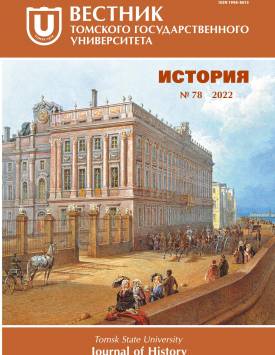Limits of effectiveness of regional economic cooperation between the USSR and China in 1985-1988
After the “cold” period in relations between the USSR and China, the intensification of interstate and regional contacts has started since 1983. However, the quality of the latter did not allow them to become a stimulus for the accelerated development of the Far East, as it was conceived in the late-Soviet projects. The article aims to determine the reasons for the low efficiency of the Soviet participation in the interregional relations of the USSR and China at the initial stage of their revival by analyzing the daily practices of interaction between border subjects. The work was carried out on the basis of archival documents of the Soviet party and Executive bodies of Primorsky and Khabarovsk Krais, Amur and Sakhalin oblasts, as well as of interviews with participants of cross-border exchanges of the considered period. It is revealed that the external contacts of the Far East turned out more profitable for Chinese partners. To disclose the factors of this situation, the article introduces the concept of “breaking system”, which includes the following components. Bureaucratic inertia. There was asymmetry in the interests of the Chinese and Soviet regional bureaucracy. The first pursued mainly trade goals, the latter - ideological ones. Fulfilling the Resolutions of the CPSU Central Committee, the Far Eastern authorities first of all were intensifying contacts through friendship societies, enterprises, sports and cultural delegations. The system of motivation and powers of the economic and party bureaucracy to dispose of local resources has not been developed. Compatibility of short-term benefits and long-term costs. In economic cooperation, Chinese provinces could not offer advanced technologies. But the problem of consumer goods shortage was more acute on the agenda in the USSR. The Chinese partners successfully used this situation, supplying abundant consumer goods. But for their part, they did not show much interest in the products of the Far Eastern industry, and bought up mainly raw materials. Social capital in cross-border relations. The use of this concept allowed to identify a set of established social relations between partners, the degree of mutual trust and of creating the ideas of cooperation. Soviet bureaucrats lacked commercial experience, awareness of international market conditions, and the ability to predict risks. The Chinese partners had an advantage in this respect and skillfully used it, achieving favorable terms of bargains. The article concludes that with the undoubted positive dynamics of cross-border relations of the Far Eastern and Chinese regions in 1985-1988, the potential for the development of this cooperation on the Soviet side had limitations, which included the reproduction of formulaic models of bureaucratic activity, a meager range of exports, the lack of mechanisms for obtaining direct benefits by exporting enterprises, the deficit of social capital. The authors declare no conflicts of interests.
Keywords
the Russian Far East, PRC, cross-border cooperation, regional development, reformsAuthors
| Name | Organization | |
| Savchenko Anatolii E. | Institute of History, Archaeology and Ethnography of the Peoples of the Far East, FEB RAS | savich21@mail.ru |
| Chernolutskaia Elena N. | Institute of History, Archaeology and Ethnography of the Peoples of the Far East, FEB RAS | chvalery@mail.ru |
References

Limits of effectiveness of regional economic cooperation between the USSR and China in 1985-1988 | Tomsk State University Journal of History. 2022. № 78. DOI: 10.17223/19988613/78/10
